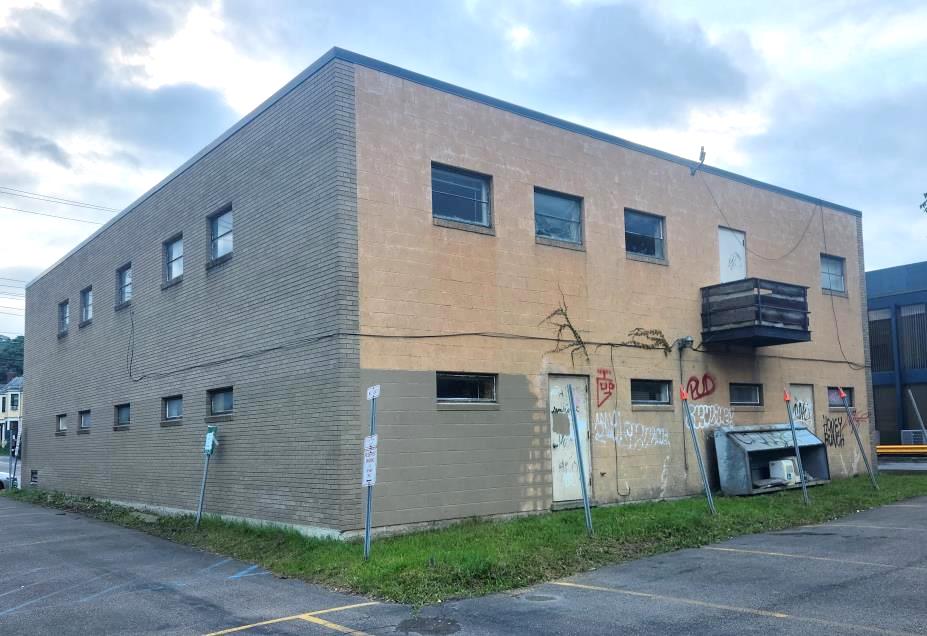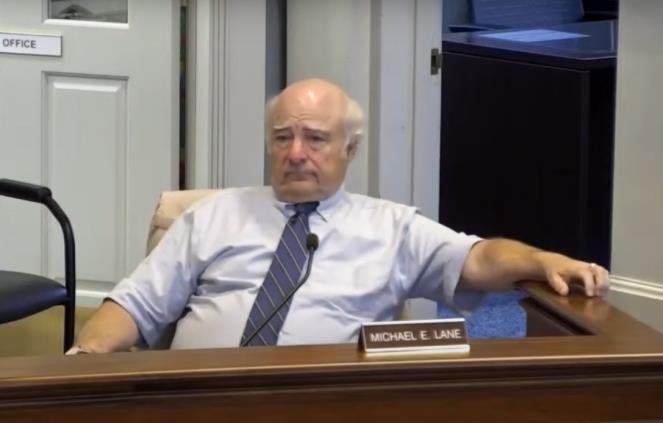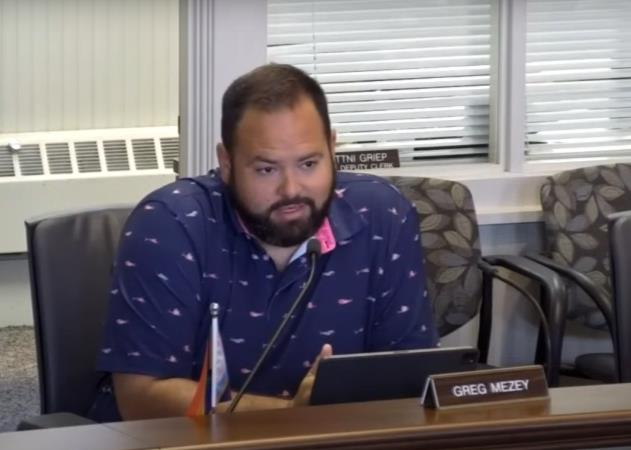by Robert Lynch, August 18, 2024
Tompkins County legislator Mike Lane is the last person you’d expect to say what he said. But yes, he said it, and in a public meeting. He spoke last Tuesday, August 13, as a key legislative committee addressed the regulatory roadblocks to demolishing downtown buildings to make way for a Center of Government.

“Should we be looking at another option?” Lane asked the Downtown Facilities Committee, on which he sits. “Should we be looking at building out somewhere else, where we could build a big-box office building, a modern office building, and not have to worry about us having to build down here?”
The Dryden lawmaker is just one of 14 legislators, yet his voice is critically influential. And his comment was a surprise. Sitting on one committee or another, Mike Lane for years has faulted other people’s suggestions that Tompkins County abandon the “Downtown Campus,” as he’s termed it, and consolidate its office space elsewhere. He’s rejected the idea that we should follow some other counties’ lead and in his words, “build in a cornfield somewhere.”
Now Mike Lane, at least in frustration, has grown an appreciation of cornstalks.
Mike Lane’s fallback option surfaced as the Downtown Facilities Special Committee heard that it may be next spring before the New York State Historic Preservation Office—nicknamed SHPO—tours two vacant buildings near the Tompkins County Courthouse, buildings County Government bought for $3 Million in 2021 intending to raze them quickly and replace them with a $40 Million Center of Government.
Those now-vacant buildings—the former Key Bank and attorney Walter Wiggins’ “Professional Building”—lie within Ithaca’s DeWitt Park Historic District. And because they do, SHPO holds leverage. The state agency probably cannot forbid demolition. But it could impede the process and stand in the way of future governmental benefits like state and federal grants.
And with the SHPO approval process dragging out much longer than expected, Lane thinks an alternative deserves consideration.
“Should we be looking at parallel tracts to look at that (a site outside of downtown), and let the folks know this isn’t our only option?” Lane asked the committee. “The City needs to know it. SHPO needs to know it. There are other options out there.”

Historic preservationist concerns about a Center of Government surfaced last year when the City of Ithaca attempted to impose control over future building designs. It relied on a City ordinance that mandated pre-demolition review by the Ithaca Landmarks Preservation Commission. In January, the County Legislature sought to pre-empt City authority by endorsing a 1988 state court decision that had granted another county in New York the right to overrule its own included-city’s development objections.
But in March, two months after Tompkins County thought it had removed the City Hall roadblock, along came SHPO. And matters have proven a mess ever since.
The Urban Renewal-era Key Bank and Wiggins Offices stand out like sore thumbs beside DeWitt Park’s other nearby buildings. The “Old Courthouse” (now called the Gov. Daniel D. Tompkins Building), currently housing the Legislature’s chambers, was built in 1854. The Italianate mansion Boardman House is also 19th Century. Likewise, the nearby Presbyterian and Baptist Churches are old. By comparison, the glass-and-steel Key Bank building and the brick-and-block law office are mere architectural youngsters. Yet SHPO considers each a “contributing structure” to the historic district and grants them grander stature than either probably deserves.
There’s a third building in play as well; so-called “Building C,” which the Board of Elections and the Assessment Department now use. It would likely come down only after the Center of Government is built. But SHPO seeks to review Building C’s historic contribution too.
So, the review bureaucracy proceeds slowly, and everybody simply waits.
“I’ve always been a strong supporter of having the Center of Government downtown, centrally located in the county, in the county seat,” said Deborah Dawson, another legislator with newly-born second thoughts. “But now a few more hurdles may convince me that we ought to be exploring another option.”
Committee Chair Randy Brown reminded Dawson that the Tompkins County Legislature has already approved proceeding with a downtown Center of Government. It did so last September.
“We can change our mind if it turns out not to be fiscally responsible,” Dawson replied.
“I agree,” Brown said.
Quite honestly, however, part of the current delay is of Tompkins County’s own making. Local planning officials want to postpone SHPO’s on-site visit until a preliminary design for the new building is ready.
Although the Tompkins County Legislature resolved its direction on a Center of Government nearly a year ago, the County still has not hired an architect, so there’s no design sketch for regulators to review. Six firms have applied for the assignment. Administrators narrowed the list to four just recently. Interviews will start soon. Legislators will pick the winner. But don’t expect anything for anybody to look at until spring.
Making sure architects are in place and an initial design has been prepared before SHPO arrives “would probably be in our best interests and help us present our strongest case for the path that we think really does make sense,” Megan McDonald, Deputy Commissioner of Planning and Sustainability, advised the committee.
“We would need something more than a “general concept,” McDonald cautioned.

All that’s now in hand is just that concept; the plan for a modern office building likely five stories high, nothing more. Decision-makers lack anything with even cocktail-napkin specificity. A few years ago, there was talk of someone’s preliminary sketch, shared privately. But it was rejected as downright ugly and incompatible with anything close to it. We, the public, never got a glimpse.
And to think of it, maybe the reason that historic preservationists and SHPO seek regulatory leverage is not so much their love for a couple of tired 1960’s buildings as it is fear of what may take their place. SHPO may have viewed—as we all have—the recent transformation of Ithaca, and what can occur when a small, booming city explodes upward when it cannot spread outward. Simply put, quirky is dying. And what historic DeWitt Park does not need now—or at any time—is for a small-windowed, gray-paneled, five-story box as its neighbor to glower over it.
Mind you, Mike Lane would rather the Center of Government not leave the downtown campus. He’s just angry that nothing’s moving forward right now. And exiting for the fields of Lansing was but one of two options he’d offered the committee that morning. The other was to stick a thumb into SHPO’s eye. (There’s a more colorful, less family-friendly metaphor.)
“We already have a Resolution on record to deconstruct the legal building,” Lane recalled. “Well, now look what’s happened. We’ve got the impediment of SHPO here. I would say again, I think we should just proceed (with demolition).”
“If we lose a grant, we lose a grant,” Lane retaliated to SHPO’s purported power. “But I think if we’re going to build a building on this corner, we need to take these buildings down, the sooner the better.”
Ulysses-Enfield legislator Anne Koreman took issue with Lane’s damn-the-torpedoes approach.
“If we are this close, I’m totally in favor of waiting for deconstruction or demolition until we get the experts on board,” Koreman told the committee.
Some, like Lane, stand tempted to snub the Historic Preservation Office. Yet it may be playing with fire. McDonald cautioned that the agency’s approval is one of those little checkboxes grant applicants in an historic district must always mark before state or federal funders free up cash.
“I can’t say no funding is available,” McDonald said. “But it would blow up that process,” she cautioned, as every state and federal agency in this situation looks to SHPO for a sign-off.
The “cornfield option” is a backup choice that’s grown momentum of late, even if largely behind the scenes. Dryden’s Greg Mezey has several times suggested the Legislature pursue it. So has Lansing’s Mike Sigler. It’s possible—though not assured—that a majority of legislators may support site relocation, though they mostly talk about it only privately. Still, some on the Legislature remain reluctant to take that left turn, particularly those from the City of Ithaca.
“I would think that taking our Center of Government out of the center of the county would be a real failure,” City legislator Rich John told the committee, as he countered Mike Lane’s “parallel tract” idea. “But I can understand the sentiment because here we are.”
“I agree with Rich that the Center of Government belongs in the center of the county, John’s City-based colleague, Veronica Pillar, echoed. “I would not support going on some parallel path somewhere else, as what it sounds like is a bargaining chip. This should be more of a ‘collaborative with the community’ process as much as possible.”
Greg Mezey that morning sat on the fence, a surprising position given his prior statements.
“You’ve heard me talk before about maybe we should look somewhere else,” the Dryden freshman lawmaker told the committee. He said he may still lean that way. “But I also think that we’ve decided to move in a path, in a direction, and we need to continue to support that; let the process play out as painful and as glacial as government and bureaucracy moves.”

From what we’re told, SHPO bureaucrats, from their far-away perch, want architects to somehow consider incorporating elements of the existing structures—if not whole buildings—into a Center of Government’s final design. Harmonizing a 50-60 year old structure with modern-day design and code requirements seems incongruous on its face. Legislators recognize that. But Albany preservationists may not.
“Is there anybody in this room who thinks that would be a wise use of money; try to rehabilitate that building and reuse it in some way?” Rich John asked rhetorically about the former bank building on the corner of Buffalo and Tioga Streets.
“Trying to incorporate part or a whole building is really going to put us at a loggerhead” when it comes to modern building codes and handicap accessibility rules, McDonald reminded the committee. “Public buildings are held to a higher standard,” she said.
“I see it very, very difficult to re-use three buildings,” County Facilities Director Arel LeMaro advised the committee. “They’re so different.”
The Downtown Facilities Committee had earlier expected the bank and legal buildings would be fully deconstructed by early next year, with deconstruction beginning as soon as now. But with SHPO staff not likely to tour until next spring, final building removal has become an open question.

“We’re on our timetable still,” Chairman Brown insisted. Yet Brown’s words conflict with an Administration timetable presented the committee last December. According to that schedule, the consultants were to have been picked by last April, designs handed up this November, the project bid next year, construction begun in 2026, and the Center of Government ready for occupancy in 2028.
Presuming SHPO can be placated, and given the Planning Department’s desire to present the pesky agency a design sketch before it comes here, Brown acknowledged reality: “The ball has rolled as far as it can roll for now.”
And legislator Lane peppered the 90-minute committee meeting with one final pessimistic observation before Brown closed it down. After Greg Mezey had suggested that the planned five-story Center of Government should be raised one story higher to accommodate future growth, Lane observed, “I think we’re looking at a $60 Million project.”
Face it, there’s nothing like a 50 per cent price hike to make a cornfield ever more inviting.
###

